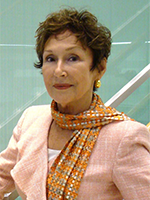Healthy aging, as described by the World Health Organization (WHO), is a process of developing and maintaining abilities that allow people to improve physical and mental health, independence and quality of life throughout the life course. Nutrition plays a pivotal role in healthy aging, but how do we develop and provide for the nutrition policies and programs that are fundamental to healthy aging in the United States?
This September, the second White House Conference on Hunger, Nutrition, and Health provides a unique opportunity to “generate ideas on how to end hunger and increase healthy eating and physical activity by 2030, so that fewer Americans experience diet-related diseases like diabetes, obesity, and hypertension.”
The White House needs to hear from a wide variety of stakeholders on what the government can and should do to reach its goals. It is important that Conference recommendations include a focus on healthy aging and the unique nutritional needs of older adults. Take action by submitting your ideas directly to the White House via their website by July 15.
White House Conferences of the 1960s and 1970s
It was not until the mid-1960s that the United States recognized that hunger and malnutrition were not just problems in other countries but were all too prevalent here at home, too. In December of 1969, President Nixon opened the first White House Conference on Nutrition, passionately urging that we eliminate hunger in America. This Conference led to almost 1,800 policy ideas and within two years, 1,650 of these were implemented. The result was development and/or improvement of wide-ranging federal nutrition programs including food stamps (now SNAP–Supplemental Nutrition Assistance Program), WIC (Special Supplemental Nutrition Assistance for Women, Infants, and Children), and expansion of the National School Lunch Program.
Existing federal older adult nutrition programs do not necessarily adequately address today’s issues.
While this Conference sought to address hunger across the lifespan, today’s most influential federal older adult-specific nutrition program, the Older Americans Act Nutrition Program, was not be created until 1971, following the 1971 White House Conference on Aging.
These Conferences have been viewed as catalysts for development of nutrition and aging policy over the past 50 years. Yet a lot has changed in America in the past half-century. Programs like the OAA nutrition program were designed based on the sociodemographic needs and size of the older adult population at the time. Such programs do not necessarily adequately address today’s issues, and without further evolution, will not address tomorrow’s older adult population and their nutrition and health needs.
Older Adults in 1969 Versus Today
What was the U.S. older adult population like in 1969? The average life expectancy was 70.7 years and those ages 65 and older accounted for just 10% of the population. Many lived with adult children or other family members (40%) and around 20% lived alone. Medicaid/Medicare had only been covering nursing home care since 1965 and around 793,000 older adults lived in nursing homes.
Today Americans are living longer. Between 1969 and 2019, life expectancy for the total population in the United States increased by almost 10 years to 78.8 years in 2019. Those ages 65 and older now represent 16% of the population, more than one in every seven Americans.
With improvements in health and mortality over the past 40 years or so, the older adult population is getting older, too. Today the “oldest old” population or those ages 85 and older (6.6 million) is more than six times larger than in 1969 (1.3 million). We also have larger numbers of older adults who are divorced or never married, without children and living outside of families. In 2020, more than 22 million older adults lived alone (about 27%), one in six had no children, and 1.5 million lived in nursing homes.
Challenges in the Years to Come
Today’s older adults are living longer, but not necessarily healthier lives. Older adults are the fastest growing segment of the population, and they also have the greatest prevalence of chronic conditions. The number of Americans ages 65 and older is projected to nearly double, from 52 million in 2018 to 95 million by 2060, and the 65 and older age group’s share of the total population will rise to 23%.
Poor nutrition is a contributor to many chronic conditions and a healthy diet can help prevent, delay, or assist in managing them.
Of those ages 65 and older, 62% had more than one chronic condition in 2016. Although the risk of developing chronic conditions increases with age, research has shown that poor nutrition is a contributor and a healthy diet can help prevent, delay, or assist in managing many chronic conditions. The oldest old are more frail, with 85% having at least one chronic condition and almost 50% needing assistance with daily activities of living. An increased percentage of the population ages 65 and older in the years to come means a larger percentage of Americans living with chronic diseases and disabilities—unless policies and programs are developed now to better support healthy aging.
The older adult population of the future also will be more racially and ethnically diverse. Between 2018 and 2060 the share of the older population that is non-Hispanic White is projected to drop from 77% to 55%. Without policies and programs put in place to help reduce health disparities, the increasingly diverse population of older adults in the future will continue to be challenged by increased rates of chronic disease.
Conclusion
U.S. policies and programs have been successful in some ways across the past 50-plus years, for example contributing to a sharp decrease in the poverty rate for older adults from nearly 30% percent in 1966 to 9% today. However, when it comes to healthy aging, we have more work to do. In 1960, the United States had the 20th highest life expectancy in the world. By 2060, it is projected to drop to 43rd.
This is not inevitable. In the next 50 years we can help the new generation of older adults—who will not be primarily cisgender, heterosexual, White non-Hispanic, aging in place with their families—find ways to live healthier lives.
Nutrition needs change with each stage in life and are influenced by health and ability, too. The nutrition needs of older adults in their 60s are different from those who are in their 90s and different still from those who have multiple chronic conditions or disabilities. Let your voice be heard by submitting your ideas on how nutrition can support healthy aging in the next 50 years directly to the White House via their website until July 15.
Laura Borth, MS, RD, CD, is the policy analyst, at Defeat Malnutrition Today in Washington, DC.









